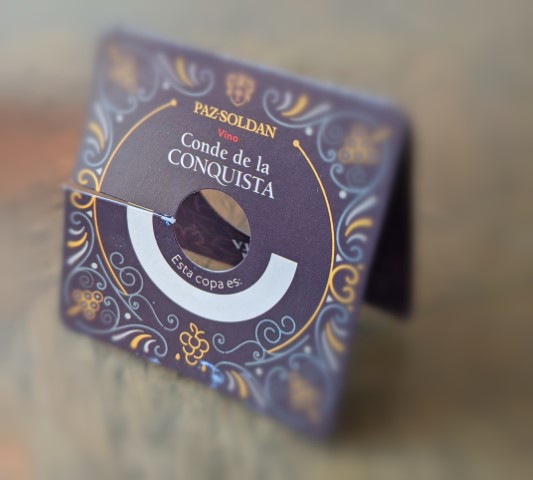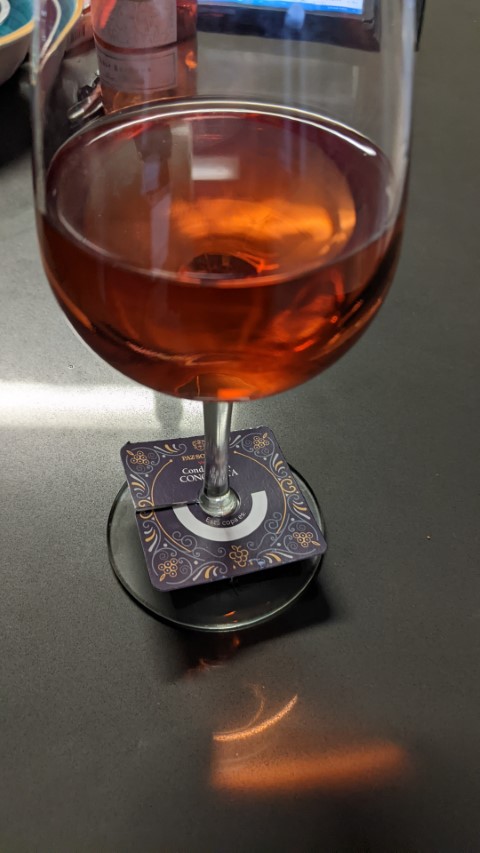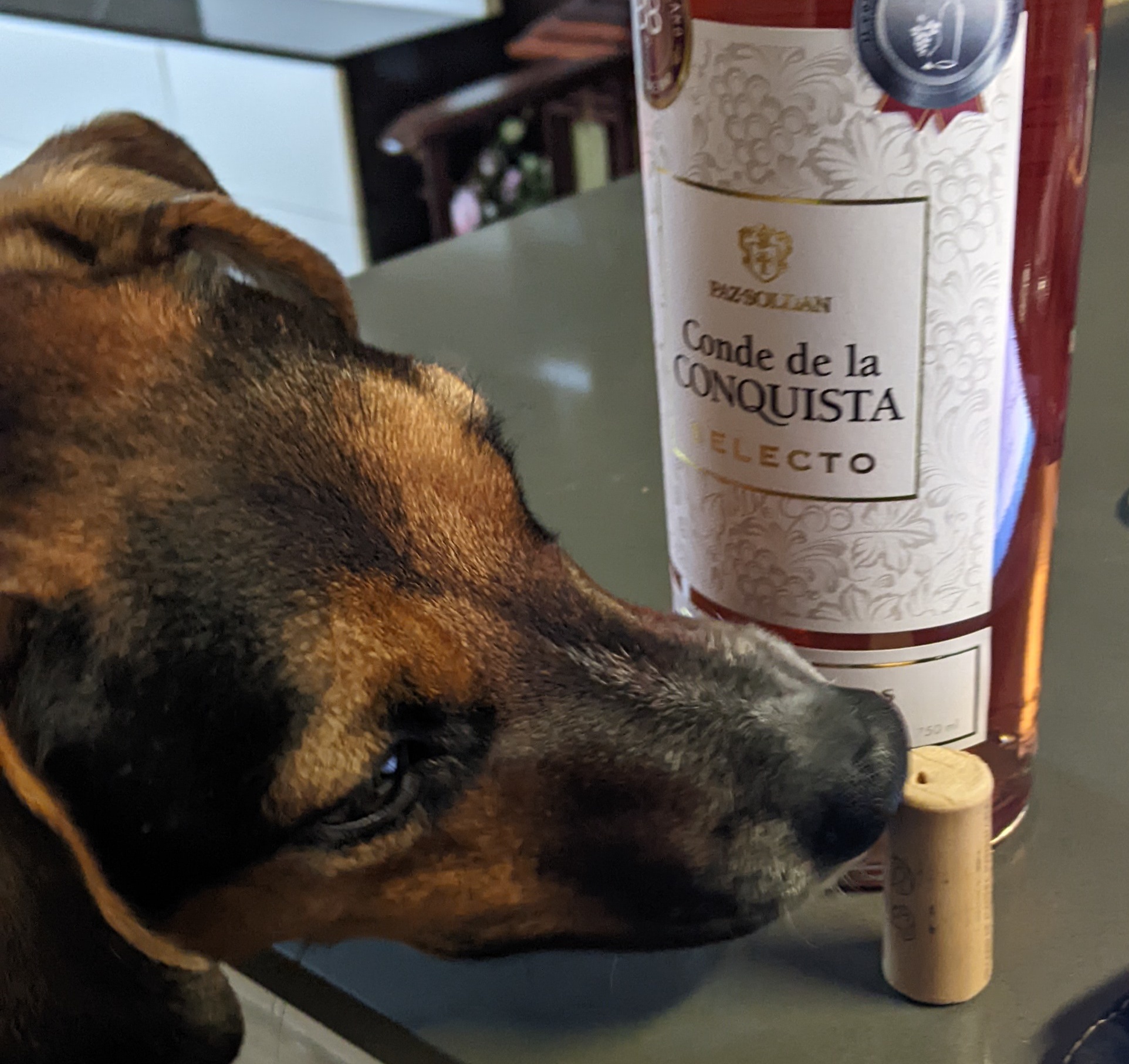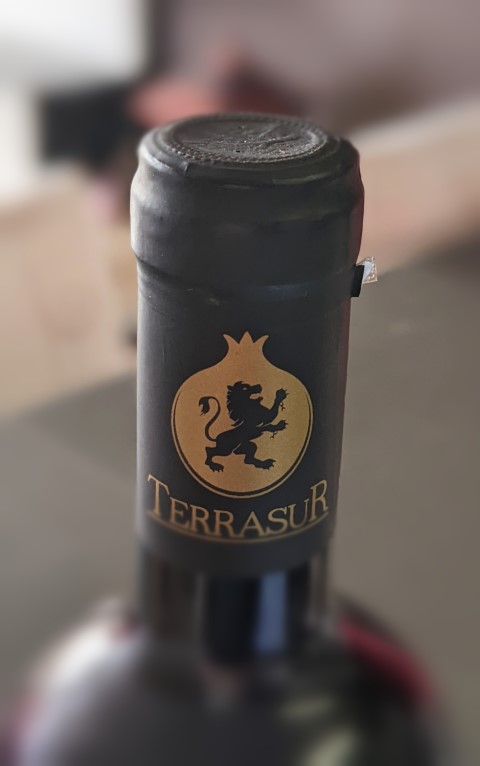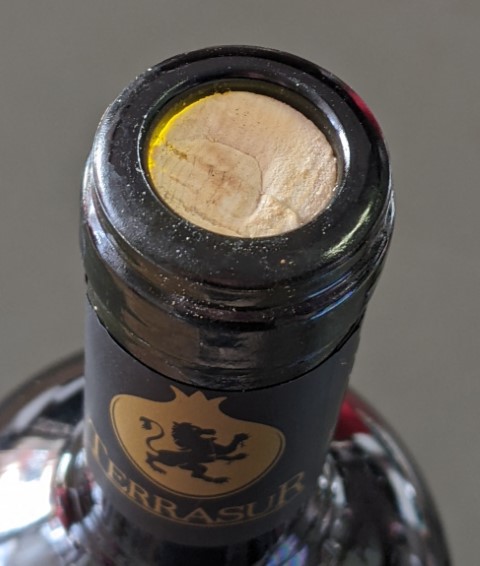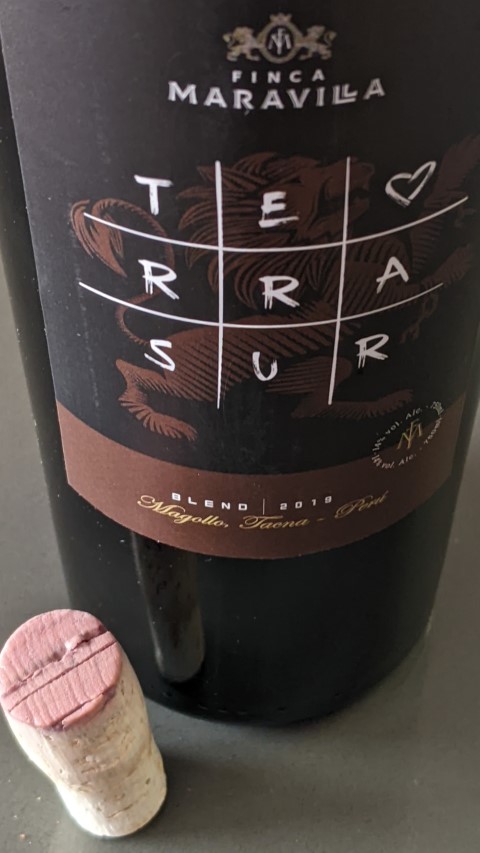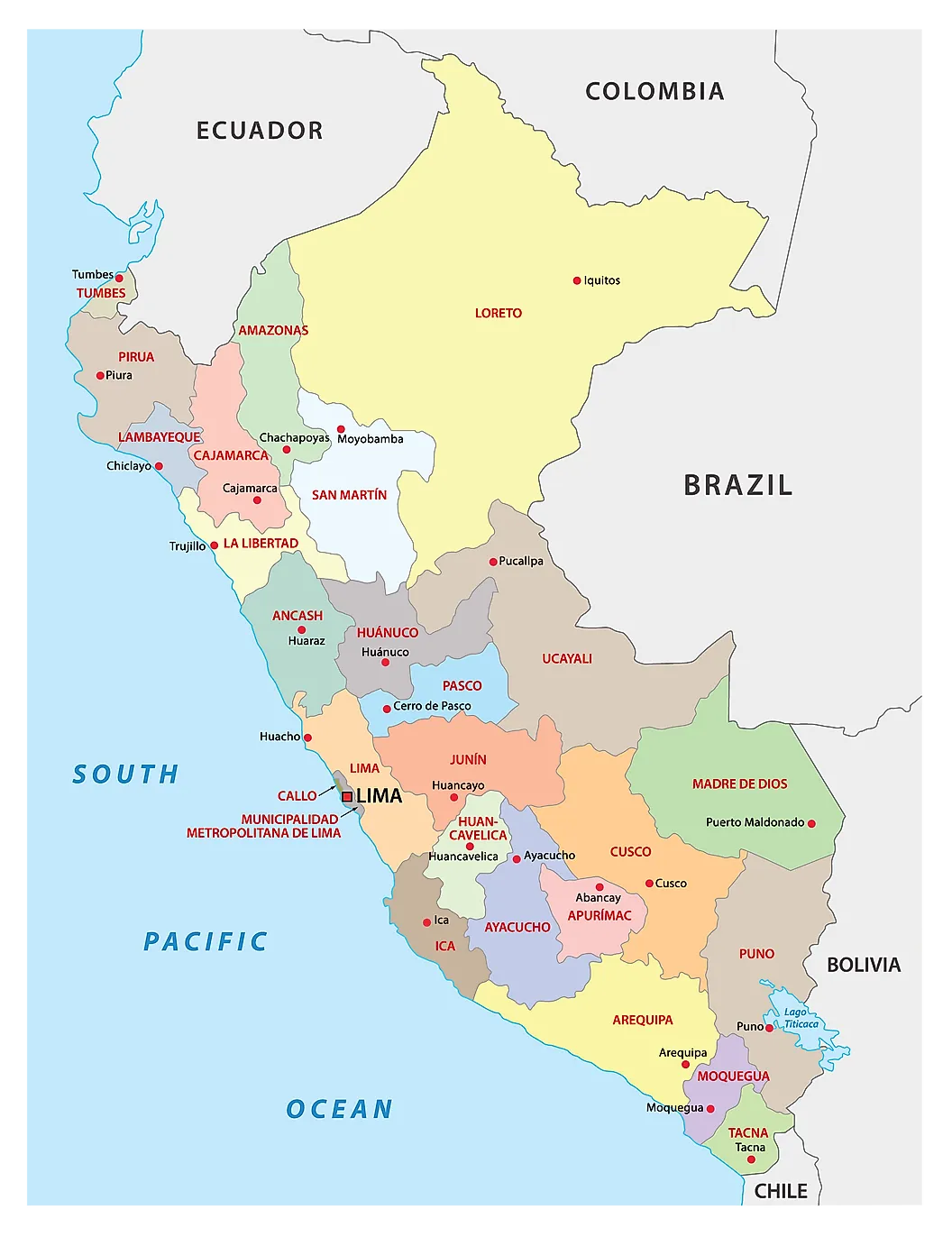
Winepisser Best Wine 2022: Bodega Finca Las Moras “Los Intocables” Black Malbec – Argentina – 2020
 2022 was a weird year for Winepisser and providing consistent reviews. First, those of us in Peru were still reeling from the pandemic, which wasn’t quite over yet. Next, I started the year off at great stride, reviewing a lot of wines in short time, and then fell off by mid-year. The crush of my day job just took over, as the pandemic eased and clients came running back to make up for lost time. From August onward, I posted no reviews at all. I was busy reviewing wines on the Vivino app, but simply did not have the time to port them over to this site.
2022 was a weird year for Winepisser and providing consistent reviews. First, those of us in Peru were still reeling from the pandemic, which wasn’t quite over yet. Next, I started the year off at great stride, reviewing a lot of wines in short time, and then fell off by mid-year. The crush of my day job just took over, as the pandemic eased and clients came running back to make up for lost time. From August onward, I posted no reviews at all. I was busy reviewing wines on the Vivino app, but simply did not have the time to port them over to this site.
Then, it has taken me until May of 2023 to do my analysis of last year’s wine and announce the Best Wine 2022 winner. That’s a shame, but the day job has most definitely impacted on my ability to provide Winepisser content. For now, at least.
So who is the 2022 winner? It’s the absolutely bonkers Bodega Finca Las Moras “Black Malbec” from its astonishingly good Los Intocables (“The Untouchables”) line. Back then I wrote:
Burn the witch, but let her finish that batch first. Astonishing malbec, probably made in a lab — a “labmec?” I’m not sure what witchcraft is at work here, but I suspect it required many newt tails. Color is as dark as Cthulhu’s soul, nose is blueberry and spice. On the palate, it’s powerful oak, blueberry, blackberry, and some spices following through. For sure this is a lab-created work, showing technological maturity by this producer. You’re going to want to touch this untouchable.
It was very nearly a tie with the equally batshit concoction from teh same winery, the Los Intocables Bourbon Barrel Malbec, except that at the end of the day as much as I liked the bourbon barrel gimmick, I had to admit it was just that — a gimmick — so handed the final award over to the less-gimmicky Black Malbec.
One of the most reliable indicators of when I’ve encountered a “Best Wine” is counting just how many times I’ve gone back to drink the stuff. Almost always, I am buying a new wine each time, never going back to visit an older one because the pressure to keep reviewing new wines is so strong for me. Testing nearly 200 bottles a year limits how many of those bottles will be “repeats,” but when I do go back, that’s a clear indicator that I just plain love the stuff. Since I first encountered the Los Intocables line in mid-2022, I have — no kidding — bought at least a dozen bottles. They are just that good.
An interesting point is how despite living in Peru, a land that’s nearly drowning in Malbec from nearby Argentina, this represents the first Malbec to win a cinco (five stars), never mind Best Wine. Frankly, when you have access to this much of any one grape, you’re going to get bored, and Malbec does bore me. I think the ink-black labeling and “Black” naming convention roped me in — much like that of the Best Wine 2015 winner, Apothic Red — but eventually it’s what inside the bottle is what matters. And I have to admit, my award for Apothic has not aged well — it’s a bit embarrassing if anything — since the wine is not reliably good, and its award was given the first year Winepisser was running, and I was still getting my sea legs. I suspect, however, that the Los Intocables label will not suffer that fate, and only improve with time. I also think folks will be joining me in this praise.
Keep in mind, the brand is not a high-end wine. The bottles cost about 65 Peruvian soles, or (as I write this) $17 US. That’s dirt cheap by US standards, but a mid-grade wine price in Peru, where a cheap wine can run 17 soles (about 4 bucks US). The wood flavors are also potent here, so snobs who don’t want their wine induced — possibly artificially — with external notes may look elsewhere.
But for the rest of us, this wine goes equally well with food as it does guzzling a glass by itself, under the moon. You don’t need to pair this with anything.
So who landed in the runner-up category? As I said, the Los Intocables Bourbon Barrel Malbec offering, but also these two great bottles, both of which won cincos in 2022:
- Bouza Monte Vide Eu (Tannat – Merlot – Tempranillo) – Uruguay – 2017
- Andeluna Pasionado Cabernet Franc – Argentina – 2018
The appearance of another Argentino wine means they took three out of the four 5-star ratings given in 2022, which is astonishing by itself. Sure, the rest of the world already knows how great Argentina is for wines, but it takes a lot to get my attention since I’m surrounded by their products. What’s also interesting is that one of those Argentinos was a cab franc, which is not always a great wine when it’s (a) from the New World and (b) not incorporated into a blend.
And, of course, we see another Uruguayan Tannat hitting the list, but this time a blend.
Some other wines tasted in 2022 that achieved 4.5 stars or higher:
- Dr. Loosen “Dr. L” Riesling – Germany – 2020 (4.8 stars)
- Hacienda López de Haro Gran Reserva – Spain – 2010 (4.8 stars)
- Dr. Loosen Dr. L Riesling – Germany – 2021 (4.8 stars)
- Château d’Arcins Haut-Médoc – France – 2014 (4.7 stars)
- Morande Adventure El Gran Petit – Chile – 2018 (4.6 stars)
- Pulenta Gran Malbec “X” – Argentina – 2017 (4.5 stars)
- Bodega Vistalba “Corte A” Red Blend – Argentina – 2016 (4.5 stars)
- Pulenta Estate “La Flor” Sauvignon Blanc – Argentina – 2021 (4.5 stars)
- Los Haroldos Nampe Chenin Dulce Natural – Argentina – 2021 (4.5 stars)
So this leaves us with this list of Winepisser Best Wines of all time, to date:
- 2022: ARGENTINA: Bodega Finca Las Moras “Los Intocables” Black Malbec – 2020
- 2021: FRANCE: Philippe Dreschler Gewurztraminer – 2018
- 2020: None — see here.
- 2019: CALIFORNIA: Klinker Brick Old Vine Zinfandel – 2015
- 2018: FRANCE: Pierre Amadieu Gigondas Romane Machotte – 2014
- 2017: SPAIN: Alvear Pedro Ximénez de Añada – 2014
- 2016: URUGUAY: Narbona Tannat Roble – 2010
- 2015: CALIFORNIA: Apothic Red – 2013
What’s planned for the rest of 2023? I’m not sure. I’ve done a lot of reviews on Vivino, but (as I said) am struggling to get them ported over to Winepisser, and thus entered into the official running. To date, there’s only one 5-star winner in 2023, a Hungarian Tokaji, but hopefully I’ll get my act sorted and have more content here shortly.
If you like the site, let me know. It helps to have some feedback, too!
Peruvian Wine Journey Entry # 4: Paz-Soldán Conde de la Conquista Selecta “Ana Maria” Rosé Burdeos – 2021
My next entry in the Peruvian Wine Journey is a pink Malbec rosé, the Paz-Soldán Conde de la Conquista Selecta “Ana Maria” 2021. This one comes from Arequipa, Peru’s second-largest city.
The Region
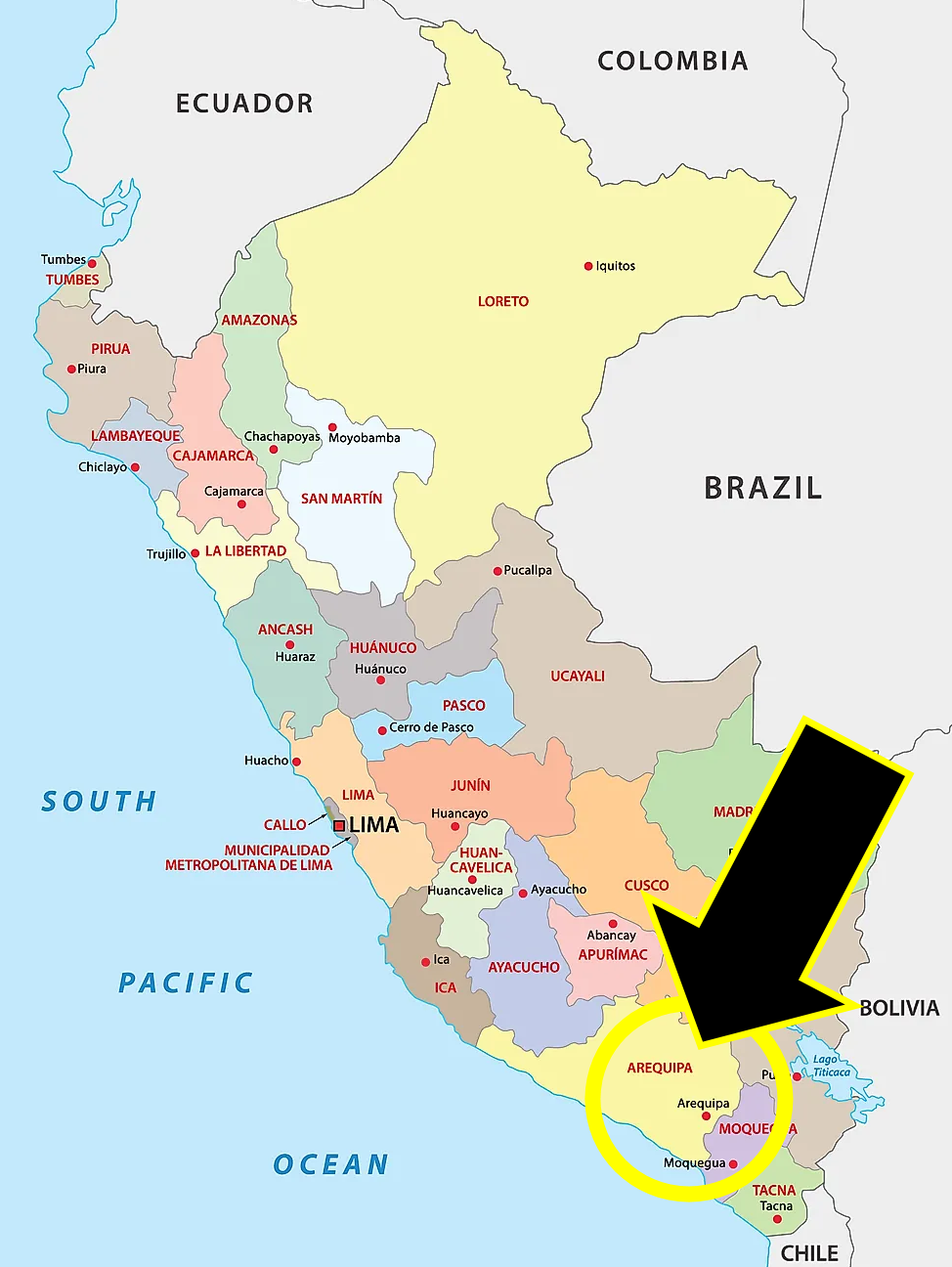 Arequipa is a region to watch. Whereas other Peruvian wine rowing regions, like Ica and Tacna, are likely to never produce a world-class wine barring some Moses-like miracle, Arequipa has most of the necessary requirements. Yes, it’s still a desert city, but has ample irrigation, stable climate, and less oppressive temperatures. There’s moving air, some elevation, and other beneficial elements that grape producers could use to their benefit.
Arequipa is a region to watch. Whereas other Peruvian wine rowing regions, like Ica and Tacna, are likely to never produce a world-class wine barring some Moses-like miracle, Arequipa has most of the necessary requirements. Yes, it’s still a desert city, but has ample irrigation, stable climate, and less oppressive temperatures. There’s moving air, some elevation, and other beneficial elements that grape producers could use to their benefit.
The region suffers from the same Peruvian mentality that is holding back the country’s wine production: obsession with pisco. Yes, we get it: Peru can make great pisco. They literally invented the damn thing (sorry, Chile, but you know it’s true.) But because you’re great at one thing doesn’t mean you should never try to be simultaneously great at something else. It’s a cultural limitation that shows itself in nearly every aspect of Peruvian culture: they are not risk-takers. If you want to open a chicken restaurant, you must locate it next to 100 other chicken restaurants; you would never dare open a place where you might be the first, and thus grab market share. That sort of thinking just doesn’t exist in Peru. God forbid you should open a cevicheria next to a polleria.
And so Arequipa is still hampered by the tendency to retool pisco production houses to occasional wine-making. The good news is that unlike the pisco producers in Pisco, Ica or Tacna, Arequipa is having a better time of it. And, slowly, some wine-makers are thinking about prioritizing wine over pisco. And guess what? The ground didn’t open up and suck us all down to hell, after all.
The Winery
The Paz-Soldán winery dates back to 1914, Google tells me. Ironically, the winery first began producing wines, not pisco, but later surrendered to national pride and pisco dominated its production schedules. I’ve had Paz-Soldán pisco, and it’s great.
But the winery’s founder, Prudencio Paz-Soldán, had already been importing grapes from Bordeaux France before he started making pisco, which is made from entirely different grapes. Paz-Soldá brought Malbec, Cabernet Sauvignon, Merlot, Cabernet Franc, and Petit Verdot into Peru, with varying levels of success. The name “Burdeos” came from a mangled Spanish translation of the plural of “Bordeaux,” but has fallen generally into use as referring to Malbec. Without Peruvian regulation on the matte, however, some “burdeos” may have different grapes in them.
Paz-Soldán is located in the Vítor Valley of Arequipa, but some of this may be not fully accurate. My research, limited as it was, seems to suggest that Paz-Soldán uses grapes grown in various plots around Arequipa, not all of which may be in the Valley, and then processed and bottled in a single facility elsewhere in Arequipa. The “Bodega Paz-Soldán” is clearly located in a desert devoid of any growth, so the grapes are not being grown there. It does seem the wine production and pisco production happen in the same building.
For this bottle, however, the labeling assures us it’s pure Malbec, grown in the Vítor Valley. I tend to trust them on this.
The Bottle
The bottle under taste test here is the Conde de la Conquista Selecta “Ana Maria” Rosé Burdeos. That’s a mouthful, so let’s break it down. The “Conde de la Conquista” part means “Earl of Conquest,” and is the general branding used for Paz-Soldán’s wines (vs. their piscos.) The “Ana Maria” labeling is dedicated to Prudencio Paz-Soldán’s mother. The label also tells us that the wine only received four hours of maceration, thus leading to its pink color (vs. darker purple.)
The bottle’s glass was clear, with a neck seal of pure white. 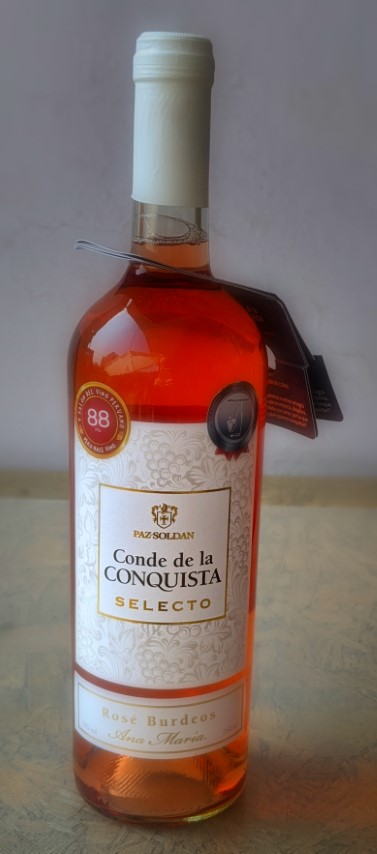
The bottle included two stickers, one indicating that it had received 88 points in the “V Salon del Vino Peruano” competition, and another for a silver medal in Concurso Nacional del Vinos Peruanos, but the year of the concourse isn’t mentioned.
The rear label had some nice information on the wine, along with tasting notes.
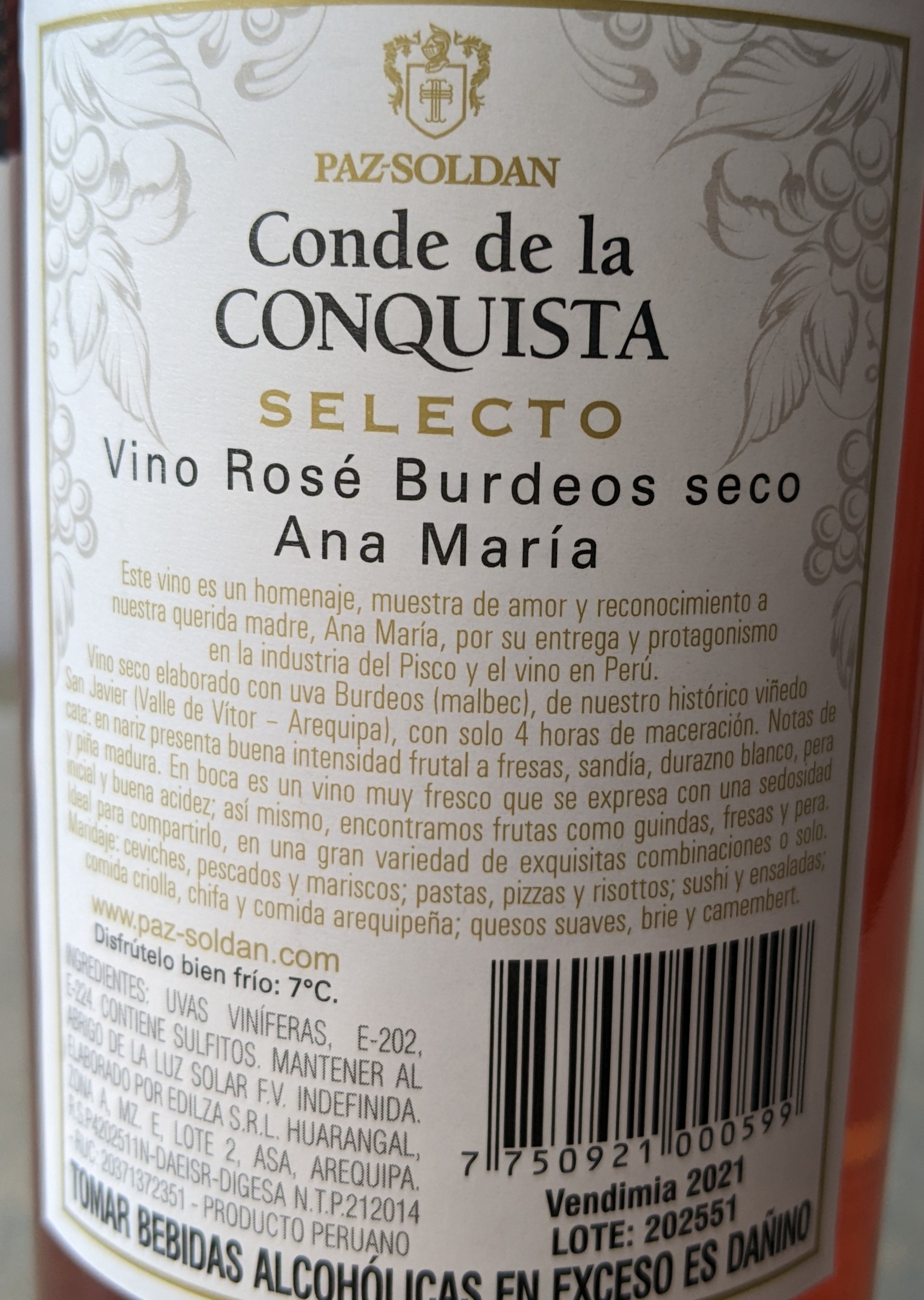 The neck was tightly sealed, and the foil opened normally. The cork proved to be a sugar cane alternative, a nice touch. Sugar cane closures are supposed to be more recyclable and generally less impactful on the environment than cork, and certainly more than synthetics. The cork popped out without incident.
The neck was tightly sealed, and the foil opened normally. The cork proved to be a sugar cane alternative, a nice touch. Sugar cane closures are supposed to be more recyclable and generally less impactful on the environment than cork, and certainly more than synthetics. The cork popped out without incident.
A really nice touch was how the bottle arrived with identification cards on the neck; this hints that Paz-Soldán is serious about having people put their wine through its paces.
The Pour
I used a slightly smaller red wine glass, but to be honest I may not know what I’m doing with rosés. My gut is just to treat them more like reds than whites, and let them get more air.
There was no sediment, and the color was pleasing to be sure. Bright pink, darker than a traditional rosé, and closer to the red side of pink. The glass showed significant legs, to be expected for the 13% alcohol level this glass was packing.
The Nose
The nose was a strange mix of baked apple, steel, and pebble. I know that’s not particularly helpful, but it’s what I sensed. Again, I’m no expert in rosés, and find them confusing. I was reliably confused yet again.
My puppy, Maui, helped me with the nose test, and he said it was just fine.
Tasting
Well, things got easier once it was in my mouth. Now the flavors provided a much clearer picture: strawberry, a bit of cherry, and unmistakable cranberry. In retrospect, the cranberry was probably what I was smelling, but I just wasn’t used to that in a wine. The finish was long, and cherry took over here.
Revisiting the bottle next day showed no changes at all, and was just as fresh as when I first opened it. Again, cranberry and cherry notes dominated. Sugar levels are moderate, and this is still a dry wine, so you won’t find cough syrup here. I tasted it by itself and then paired with some cheese (queso blanco) and crackers, and went equally well. I’m not sure how this will hold up against any powerful meal, and so definitely suggest you pair this with either something light, or nothing at all.
I shared glasses with others at the table, and they enjoyed it, too. The others all prefer sweet wines, so getting any positive comments on a dry wine was nothing less than miraculous.
Overall, this was a hit. If I had to come up with negatives, it’s perhaps a bit too acidic (the cranberry notes are tart), and could use more balance with the sugar.
Final score: 4.2 stars.
For more entries in the Peruvian Wine Journey series, click here.
Peruvian Wine Journey Entry # 3: Finca Maravilla “Terrasur” Red Blend 2019
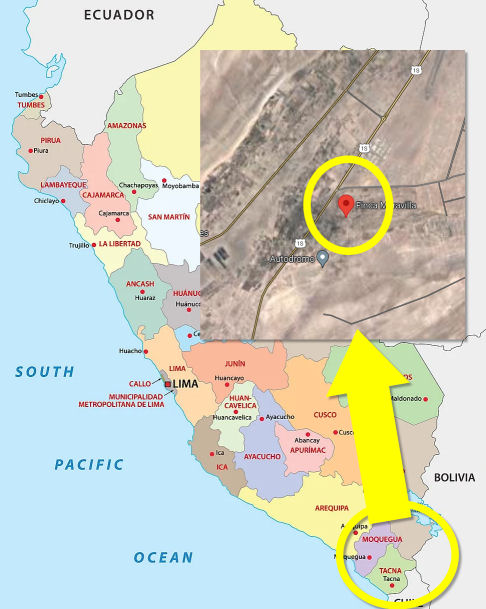 How Finca Maravilla is making wine in one of the driest places on the planet, Tacna Peru, is curious to be sure. Thanks to water running off the Andes via the Río Uchusuma, Tacna has some patches of green along the river’s edges, but not much else. It’s a huge gamble, and entirely reliant on that runoff. Some years are better than others, and everything is precarious due to climate change.
How Finca Maravilla is making wine in one of the driest places on the planet, Tacna Peru, is curious to be sure. Thanks to water running off the Andes via the Río Uchusuma, Tacna has some patches of green along the river’s edges, but not much else. It’s a huge gamble, and entirely reliant on that runoff. Some years are better than others, and everything is precarious due to climate change.
The Region
Finca Maravilla is, like most wineries in this region, first and foremost a pisco producer. As I wrote before, this is often a red flag. A great pisco maker does not reliably translate into a great winemaker; the grapes are different, as are the processes, equipment, and required terroir. But a lot of pisco producers figure they have enough of a toe in the water in “alcoholic beverage production” to wade from the pisco end of the pool into the winemaking end.
The Terrasur Red Blend is a blend of Cabernet Franc and Cabernet Sauvignon, blended with a primary element the label calls out as “Grenache-Syrah-Malbec.” This also hoists some red flags. First, why three of the grapes would be hyphenated together implies — but doesn’t outright state — this was something that was blended already, before having the cabs added. Next, it seems unlikely that Finca Maravilla has enough physical real estate in Tacna, much less the reliable weather and ground conditions, to grow plots of five grapes. Google Maps satellite view suggests they might, but the region is a vast, dead desert, with a rocky, sandy ground cover that makes planting anything a challenge.
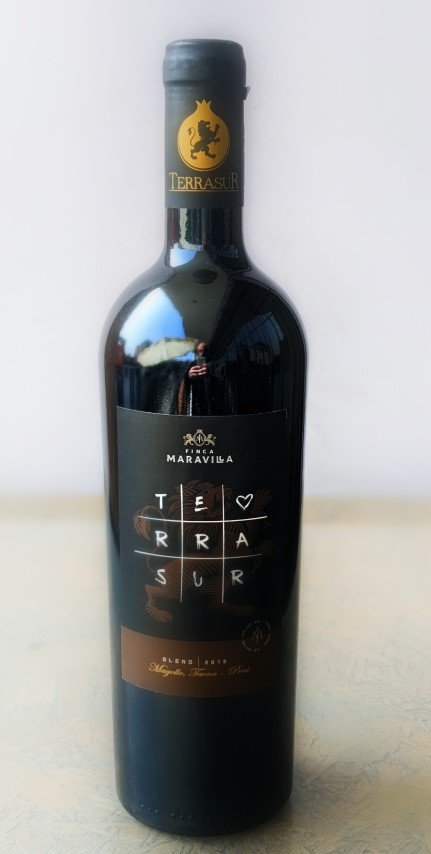 So my spider-senses are telling me that this is a blend of wines produced elsewhere. But I’d probably be wrong. The Terrasur brand includes different offerings of standalone Cabernet Franc as well as Cabernet Sauvignon, and the marketing insists they’re made right there in Tacna. Ditto for a Terrasur Malbec. I’m still not sure where the Grenache and Syrah come from, though.
So my spider-senses are telling me that this is a blend of wines produced elsewhere. But I’d probably be wrong. The Terrasur brand includes different offerings of standalone Cabernet Franc as well as Cabernet Sauvignon, and the marketing insists they’re made right there in Tacna. Ditto for a Terrasur Malbec. I’m still not sure where the Grenache and Syrah come from, though.
So, until I physically visit them — which isn’t going to happen this year, at least — I have to keep wondering.
The Bottle
The bottle of Terrasur Red Blend arrived without incident, and showed promise. The bottle itself is black glass, hiding the contents but also protecting it from light. A black label was very well designed, but did show signs of peeling on one corner. Hmm.
I liked the Terrasur logo, a tic-tac-toe design that hides a cute secondary message. With each letter of “Terrasur” inserted into one of the available spaces, this left one space blank… so the designers added a heart symbol after the “T” and “E.” This is read as “te amo” in Spanish — meaning “I love you.” It’s cute, and well thought out.
Throughout the design is the lion imagery, which represents Finca Maravilla’s main crest logo. The name itself means “Wonder Estate,” if you’re interested. I think this lion branding adds a nice bit of regality to the entire brand, and shows some level of sophistication. As we will see in future reviews of Peruvian wines, “sophistication” is not a given.
The back label provided a high level of detail, including a rough idea of the blend (although no details on actual percentages), tasting notes, etc. As I wrote previously, none of this is regulated under law yet, so clear information is always welcome on a Peruvian wine bottle.
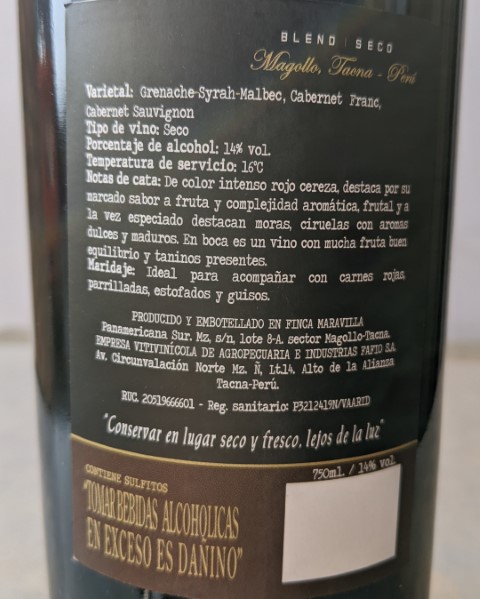 The label insists, however, that the wine was bottled “en” Finca Maravilla — meaning on-premises, as I read it — as opposed to “por” Finca Maravilla, which would mean by them, and not at any actual location. So FM has gone all-in on insisting they’re bottling the stuff, and that it wasn’t a blend made by someone else, elsewhere in the country.
The label insists, however, that the wine was bottled “en” Finca Maravilla — meaning on-premises, as I read it — as opposed to “por” Finca Maravilla, which would mean by them, and not at any actual location. So FM has gone all-in on insisting they’re bottling the stuff, and that it wasn’t a blend made by someone else, elsewhere in the country.
The neck was properly sealed, which you must check with Peruvian wines. The foil was professionally attached, and pulled off normally. Again, some Peruvian bottlers haven’t mastered tasks we take for granted, like applying the neck seal, and some bottles aren’t sealed at all. The Terrasur bottle appeared no different than any normal wine from France or California in this respect, which was good news.
The cork, on the other hand, hinted at problems to come. Upon inspection, the cork looked natural — real cork, in other words, and not synthetic — but very pale and dry. This is common for Peruvian wines, since they often buy cheap cork from unreliable manufacturers. Such corks are rarely printed with any information, because the cork producers don’t want to spend money on stamping equipment. It’s common to find flimsy, bone-dry corks in cheaper, less professional wines in Peru, but this cork seemed to contrast against the highly professional presentation thus far.
Sure enough, it didn’t get better once the cork was pulled. It removed well enough (using a waiter’s key), but was so very dry, it gave off a slight cork powder in the process. The color of the underside threw up another immediate red flag; although perhaps calling it a “pink” flag would be better. The coloring was the palest pink I had seen since opening a rosé. The image below does the actual color justice; it was that pale. There was no marking on the cork, a sure sign of a cheap cork-maker.
This suggested the wine was stored upright, keeping the cork dry, and thus failing to protect the wine from air. A “wet” cork — soaked in wine that has been stored at an angle — expands the cork and tightens the seal. To store wine upright is a rookie error, and falls on both the producer (Finca Maravilla) and whatever distributor they are using. Since small Peruvian wineries may not even have a distributor, it’s likely that FM ships the stuff direct to the seller — in this case Peruvino — and it’s sold as-is. Peruvino rotates through its stock fast enought that it doesn’t do any long-term storage, so I’m putting the blame for this directly at Finca Maravilla.
Now remember that the vintage on this is 2019. It’s not an old wine by any stretch, but had the wine been stored properly, there’s no way this cork would be this color after nearly two full years.
The Pour
Pouring into a traditional red wine glass revealed no sediment, and a light purple color, nearly rusty. Tilting the glass revealed an amber middle, with not much opacity.
Despite a 14% level of alcohol, the legs on the wine were slight. There was very little adhesion to the glass.
The Nose
The nose immediately revealed “brett.” This is Brettanomyces, a yeast that can occur in some wines and has the potential to cause real damage. The resulting “brett” smell is that of horse or cow stable — in other words, shit — but in light amounts can actually enhance a wine. The level of brett tolerable by a person is highly individual, and the presence of brett isn’t always an indication that the wine is bad. For me, a little brett on the nose is fine, as it can enhance an earthy red.
Runaway brett, however, can cause disaster, especially when it follows through to the flavor profile. In 2017, the Winepisser Worst Wine award went to Franclin Delgado Castilla Cavas de Caral 2015 — from Peru, too, alas — because of overwhelming brett. I hadn’t known much about brett at the time, and didn’t realize that what I was tasting than even was brett. After having had the same experience a few times with Peruvian wines, I know now.
In the case of the Terrasur, my initial notes on nose were “horse stable” but also blueberry. So at this point, the brett wasn’t a deal-breaker.
Tasting
Now it was a deal-breaker. Tasting the wine proved the brett had carried through, and how. The stable flavors were now masking nearly everything about the wine, making it near impossible to even identify other notes. “Maybe some red berries?” I wrote in my notes. I was struggling.
I could make out some mouthfeel at least. Tannins were very smooth, and the acid was medium. The wine itself was super-dry, and pleasantly so. Had this thing not been tainted with brett, it might have been a good — although not great — red blend.
I knew brett doesn’t dissipate, but I gave the glass a second and third try out of pure desperation. For the second round, I let it sit for 15 minutes and revisited it. No change. I then poured a new glass through a Venturi, to try again. No change.
At this point, pairing with food wasn’t going to help, but I did my due diligence anyway. The plate was a simple hamburger and rice dish (hamburger served on the plate, not as a sandwich), and typically perfect for pairing with a red for taste-testing. No help here. After about a half-hour of trying, I gave up. It was undrinkable. The rest went down the drain — a clear sign of bad, bad wine.
Final score: 2.0 stars, giving the wine some extra credit for overall presentation, color, labeling and mouthfeel. I’m being, admittedly, generous.
Closing Notes
Other reviews on the Vivino app show the same exact vintage getting higher reviews, with no one mentioning brett or horse stable notes. A few drinkers actually enjoyed it. So whatever happened seems to have been unique to my bottle or, more likely, a few cases.
Brett really can’t happen from poor handling or storage after production, and must be introduced by the producer. So my thinking is that the batch has it uniformly, but the low-quality cork and upright storage gave this particular bottle the right conditions to allow the brett to grow wild. Perhaps other bottles were stored properly, and the brett never cultivated properly.
I’ll try another Finca Maravilla some day, sure. But for now, the first review of this Peru Wine Journey was a dismal disappointment.
For more entries in the Peruvian Wine Journey series, click here.
Peruvian Wine Journey Entry # 1: An Introduction
As a US immigrant living in Peru, it took a long time to get used to living in a very different society, under a very different culture. Related to wine, I’ve been complaining nonstop for about ten years over the state of the wine industry here. Peruvians’ palates tend towards sweet wines, as in saccharine treacle. If it doesn’t taste like liquified sugar cane, they don’t like it.
This has left the bulk of wine production to companies who cater to that taste, like Intipalka and Tacama. Both offer dry wines, but the quality is generally lacking, and even then they sometimes have a sweet tinge to them. Beyond that, smaller — but nevertheless prominent — producers emphasize the use of the “Borgoña” grape, which you’re supposed to think has some relationship with Burgundy (“Bourgogne”), but is really a table fruit grape not intended for wine. Santiago Queirolo is a major sinner here, in this aspect; Peruvians have some sense of national pride about Queirolo, and often serve it at weddings and other events. They have no idea the stuff is absolute garbage.
Geographically, wine production generally centers around the Ica region, where Pisco — Peru’s national alcoholic beverage — is also made. As we’ll discuss in another article, Ica is not ideal for wine production at all, and forces producers to get creative in addressing its challenges.
So I was happy to find a relatively new company called Peruvino which has an entire catalog of wines produced in Peru, with offerings from regions beyond Ica. I was intrigued, and thought I might start a series of reviews of these various wines, from various Peruvian regions, and see if we can get past the sweet Borgoña junk. Each entry in this series will focus on one specific bottle, and give a bit more details about the wine and its overall presentation, since solid information about Peruvian wine is scarce.
Challenges
I’m going to focus on “presentation,” as I said, because Peru is a young winemaking country, and some of the basics still haven’t been sorted out. Things like labeling, packaging, sealing bottles, label information, and logistics (shipping and storage) are problems. Things you take for granted in countries with established wine production simply aren’t standardized here yet.
Whereas Peru’s pisco production is regulated to some degree — it can’t be called “pisco” unless it’s literally made in Pisco — the same doesn’t hold true for Peruvian wine. There is no national appellation system in place for wine yet, and no rules at all for labeling. It’s the Wild West here, and consumers have to proceed with caution.
Even things like “vintage” are not adopted with any consistency. Some bottles may have been produced in a given year, but the producers don’t know enough to put the year on the bottle. In other cases, producers put the year the wine was bottled, but that’s no assurance the wine inside isn’t a blend of various production runs over a span of years. Finally, producers can just outright lie, and put dates on labels that don’t actually reflect the truth. As I said, it’s lawless.
If any country would benefit from adopting screwtops, it’s Peru. The wine consumer here isn’t so snobbish as to demand the “legacy experience” of pulling a cork, and – let’s face it — screwtops are both cheaper and better than cork. (I’ll have another article on that shortly.) Countries avoid converting to screwtops because their consumers are used to corks; that’s simply not the case here. New Zealand pulled off the switch to screwtops and had an established wine industry already; the path would be much easier for Peru. And, as you’ll see, Peru wines suffer routinely from poor storage, pork corking, and the use of cheap grade corks that ruin the bottle. All of those problems would be resolved by a law demanding screwtops.
Next, you can’t really be sure what grape you’re getting. Higher-end producers — or would-be higher-end producers — are likely to be honest on their labels, because they want to be taken seriously. But with no regulatory oversight, other Peruvian producers can put whatever they want on the label. I once had a bottle that was labeled cabernet sauvignon but was clearly, unmistakably the horrid Borgoña raisin.
Finally, Peru has a climate that is horrible for logistics. Shipping finished bottles from the bottler to a distribution center, then to a local wine shop, presents about three to four points of risk for temperature damage. Lima is a desert city on the ocean; its summers are hot, and its winters are muggy and damp. Warehouses and tiendas must be air-conditioned to maintain wine, and — if I’m being completely honest — they just aren’t. Your local wine shop is nearly never going to be airconditioned. A higher-end shop might have a walk-in cava, but even then there’s no way to know if they just turn the thing on during the day, when people are in the shop. One of the bigger supermarket chains here is Makro, similar to Sam’s Club in the USA, and offers wine by the bottle or case. But the Makros have no air conditioning at all, and shopping in them is a sweltering, sweaty experience in summer. Once I realized most of the wine I had been buying from Makro was temp-damaged, I stopped buying wine there entirely. Supermarkets like Wong or Tottus are well air-conditioned, but you have no idea if the wine was already damaged during transit to the store.
And no Peruvian shipping truck is going to be air-conditioned either, unless the producer is very rich and using very expensive, professional shippers. Instead, wines are carted around in the back of used vans, in cardboard boxes thrown next to the spare tire. I was pleased to see Peruvino had its own branded vehicle to deliver my wines, but it was not air-conditioned. As I write this, it’s winter here, but the wine would have been at severe risk for damage if I was getting anything delivered in, say, January when the temperature inside a car can hit 90 degrees F, easily.
So I am going to dissect these Peruvian wines like a surgeon, and really try to find out what’s happening here. I want to disprove the theory that Peru can’t produce good wines, and sort out the bad ones. I’m convinced Peru can be a solid, high-quality producer and emerge, as Uruguay has recently, to become a new darling for international wine drinkers. Let’s see how far off that dream is.
For more entries in the Peruvian Wine Journey series, click here.
Let Them Fight! Two Argentino Syrahs Get Into Messy Scrap
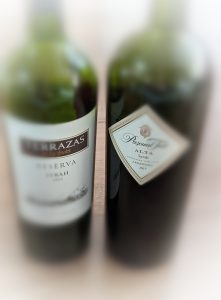 I hit a local wine shop that I thought would have a good selection — they call themselves a “gourmet” food and wine joint — only to find it was awash in the usual selection of Chileno and Argentino reds, mostly malbecs. This is the life in Peru, alas.
I hit a local wine shop that I thought would have a good selection — they call themselves a “gourmet” food and wine joint — only to find it was awash in the usual selection of Chileno and Argentino reds, mostly malbecs. This is the life in Peru, alas.
That’s not saying it’s a bad thing, but sometimes I’d like white wine, y’know?
So I realized I hadn’t really gotten too deep into the Syrahs of these countries, so I thought I’d put together a little taste test between a few of them. When the time came, I was the only one tasting, so I limited myself to two selections, since I’d be the only one drinking. I chose a 2011 Terrazas de los Andes Syrah Reserva, and a 2017 Pascual Toso Alta Syrah, both from the Mendoza region of Argentina. I typically like Syrah, but definitely lean towards the Australian Shiraz if given a choice. I find the Argentine offerings largely flat, and dramatically similar from label to label.
These were both medium-priced; not top shelf, but not lying on the floor of the wine shop, either. I think they ran about $30 apiece. I also ran these past the Vivino app beforehand, and found them holding moderately high ratings (4.2 for the Pascual Toso, 3.9 for the Terrazas.)
I was primed for this face-off. I set up my tasting area, threw down a labeled placemat so I wouldn’t confuse the two glasses, and then … everything fell apart pretty quickly.
The Shit-Show
First, I had the wrong wine glasses. I’m a wine slob, not a wine snob, so I wasn’t too worried. The glasses used were slightly narrow-mouthed, and intended for whites, but this was just me sitting there, so no one was looking.
Next, the cork on the Terrazas crumbled mid-way. That’s a bad sign in Peru, since so many of the wine shops have unreliable air conditioning, and some of the delivery trucks aren’t temperature controlled at all. As a result, it’s common to have bottle after bottle tainted with heat damage. A crumbled cork can indicate this, so I was nervous off the bat. All attempts to remove the remaining portions of the cork failed, and I was forced to shove the remaining bits into the bottle, and serve the thing through a filter screen.
I had already opened the Pascual Toso, and then the third cock-up happened: I switched the glasses on the placement. I wasn’t completely sure which was which anymore. So I had to put the glasses aside and re-pour. I wasn’t about to go into a tasting session unsure of what I was drinking. I’m an idiot.
Finally, the food arrived. I like to test wines alone, and then paired (if possible). The dinner was supposed to have been carne (beef), but someone changed things up and served fish instead. This was pan-fried bonito, which is not a tepid whitefish, but still… I wanted to bounce these wines against a cow, not a gilled creature.
At that point, I just said, “screw it,” and got on with the whole thing.
Tasting Notes
First out of the gate was the Pascual Toso, which had the higher rating on Vivino. The nose was very flat, with some earth notes and blackcurrant, but just barely. That’s common with Syrah, the nose often won’t telegraph too much, but this was outright shy.
I went over to the Terrazas, and found the same. Maybe black cherry here instead of blackcurrant, and less earthy, but still very, very timid. I decided this might have been due to the narrow glasses (unlikely, but maybe?) so let them sit for about ten minutes to see if anything opened up.
It didn’t. Both were the same when I came back. So I started drinking.
For the Pascual Toso, more blackcurrant came through, along with some spices and black pepper. This was, despite the year (2011) still really acidic. The sugar was nearly absent, which didn’t help. Sometimes, a peppery, acidic wine can be saved by a quantum of sugar, but this one had none of it. The blackcurrant fruit note was great on its own, but that pepper wasn’t helping.
Paired with the fish, things actually got better. I imagine this would have been better with a hamburger or filet mignon, but pairing definitely helped. I ended up giving this a rating of 3.7.
For the Terrazas, I was ready to wince. Remember, this was the bottle with the crumbled cork, and I suspected heat damage. Taking a swig, I didn’t find any. It was actually better — albeit only slightly — than the Pascual Toso!
The main flavor note here was black cherry but with a licorice kick. I don’t like licorice, mind you, but in a red wine I find it pleasant. The tannins here were much smoother than the Pascual Toso, and the sugar was slightly higher, but don’t be fooled: this is still a dry red. The acid was lower, too.
But the finish was lacking, and pairing it didn’t improve at all. In the end, I rated this one 3.8.
The Winner
So the winner was the Terrazas, but only by a tiny bit. Both were generally disappointing. Fine to drink, sure, but not what I was expecting. I find Vivino ratings are generally lower than my own, so I assumed both Syrahs would win better ratings from me. They didn’t; in both cases, my ratings were lower.
What was odd — and maybe fun, in the end — is how the Terrazas came out on top at all, given the cork problem, the risk of heat damage, the screw-ups by yours truly, etc.
But this brings me back to the fact that I seem to enjoy Shirazes better than Syrahs. I also enjoy US Syrahs more than the ones I’ve had from South America, so far. I’m starting to think I’m just not a fan of Argentina’s offerings for this grape.
Getting a 5-Star Review Just Got Harder
As some of you may know, I typically publish my initial review reactions to a wine on the Vivino app. Then I hone them a bit before porting them over here to Winepisser.
Well, Vivino just upgraded their rating system to allow for more incremental ratings. Whereas you were limited before to half-stars, you can now crank ratings in decimals (4.5, 4.6, etc.) This provides a bit more freedom and flexibility in rating, but it also means it’s going to get a lot, lot harder for wines to rank a full 5.0 here at Winepisser.
And I think that’s a good thing. I originally started this blog so I could verbally thrash trash wines, but since I don’t actually like drinking garbage, I tend to shop and taste the better ones. I’m still a street-level wine thug, and keeping my purchases at the appropriate shelf level, but I’m not actively browsing the bottom shelf just for snark opportunities. So a lot my 4- and 5-star ratings were a bit forced. With the new system, I can be more selective… and I tend to be.
If you do use the Vivino app, be sure to follow me over there, too.
I Accidentally Created a Gewurzcorbiner Rosé, and Re-enacted World War II
I like to remind people that I’m a wine slob, not a wine snob. A street-level wine thug, as the saying goes. I mean, hell, the site’s called Winepisser, for heaven’s sake. So don’t hold this next one against me, but I will take credit for creating an entirely new wine industry if it proves popular.
I really had bad luck with one particular bottle of Riesling, that being the 2018 Markus Molitor “Haus Klosterberg” Riesling. First, I asked one of my wine shops to order me a German Gewurztraminer. So while I’m a fan of the Mosel region rieslings for sure, I’m an absolute gushing lunatic for the g’wertz. So to find out I had been delivered a reez instead, well, it was a disappointment.
Not a giant one, mind you, because Mosel reezes are so reliably fantastic. This one, however, didn’t really work for me… and I’m more shocked than anyone to write that. It still earned 4 stars, but given the fact that Mosel region wines so reliably hit 4.5 or even 5 stars with yours truly, it was a little bit of a letdown. I also had to squint to give in a full 4, and it was likely more deserving of, say, 3.75. But the rating system (borrowed by me from Vivino) doesn’t work like that.
So I’m muddling through this 4-star German riesling, and hardly complaining about it.
So imagine my surprise when I used it to accidentally create an entirely new wine, one that would shock the wine world forever.
You see, I was in a hurry. I was called downstairs for lunch, and had a glass of the Molitor already half-drunk. So I went to refresh before I hurried down, and reached into my wine fridge. I picked up the bottle, uncorked it, and started pouring.
Like Rameses II when Moses shoved a stick into the Nile, I was shocked to see my white wine turn red. I had accidentally grabbed a bottle of the 2019 Blason d’Aussières Corbières, and splashed it into my Riesling.
Good lord, had I just committed a sin? Would the sommelier priest-kings of Bacchus visit me with plagues and famine? Would my subscription to Wine Spectator be canceled on the spot? Would Chateau Ste. Michelle finally have their vengeance?
Worse, had I just used God’s divine fruit — the grape — to re-enact the Saar Offensive, where France invaded Germany? I mean, sweet Jesus, I even had the regions right!
Breathe, I said. No priest-kings are knocking at the door. I thought I might, instead, change my thinking. Maybe I had just uncovered some new trend? Maybe mixing random bottles of wine could be a “thing”? Much of that would depend on how this instantaneous rosé actually tasted.
I wish I could tell you that I uncovered some new, untested phenomenon. I wish, like Newton getting hit on the head with an apple, I could say I stumbled on something wonderful. The resulting Gewurztraminer/Corbières blend I had created — let’s call it a “Gewurzcorbiner” — had a sparkly red color, probably a lot less like the bloodied Nile, and a nose very much like Cherry Coke. The flavor notes were… not good. The Cherry Coke seemed to carry through, likely due to the slight fizz of the Molitor, but then there was an aftertaste of meatiness from the red that didn’t mesh well with the citrusy notes of the white.
So, no, I can’t recommend people go out and try a 2018 ½ Gewurzcorbiner.
I’m intrigued, though. What if someone did actually make a case for in-glass blending of entirely different wines? I can’t help but think thar’s gold in them thar hills. While my Gewurzcorbiner blend was a disaster, I can imagine other in-glass blends being very good. Or, at least, challenging to try. A pinot noir with 25% pinot grigio? A super Tuscan going 50-50 with a Chablis? What if we went nuts and blended a 5-puttonyo Tokaji with a shot of Niagara icewine?
I dunno, I think I’m onto something and just haven’t fleshed it out yet.
Every Wine Review of 2021
As you may have noticed, in 2021 I began reviewing wines by adding one-liner blurbs, or quips. Let’s call them “burps.” I did this because Winepisser wasn’t nearly as clever as I had imagined it, and was getting to be yet another stale wine blog. Since I’m a writer, I figured I should put my literary powers to good work, such as reviews of alcoholic grape-based products.
Here are all the reviews for 2021, in one place.
You fall asleep naked in a meadow of honeysuckle when, suddenly, a chorus of angels rains the blessings of heaven upon you while playing Debussy; Jean-Luc Godard wishes he was this breathless. Philippe Dreschler Gewurztraminer – France – 2018
If Dr. Frankenstein had stitched together his creation, and it came out an Adonis. Bodega Norton Quorum VI Red Blend – Argentina – NV
A top-down Lotus drive through a citrus field on Sunday morning. La Val Orballo Rias Baixas Albarino (Fermentado en Barrica) – Spain – 2015
A day of shopping for luxury furs marred only by your looming credit limit. Chateau Haut-Surget Lalande-de-Pomerol – France – 2019
Valedictorian-in-running later graduates to run pastry shop. Chateau Haut-Caplane Sauternes – France – 2017
Delicate flirt carries ornate-handled switchblade. Chateau des Fines Roches Chateauneuf-du-Pape – France – 2015
Mysterious figure in a dark car park winds up being a great pal. El Coto Blanco Rioja – 2020 – Spain
Your mysterious car park pal has a cousin. El Coto – Coto de Imaz Rioja Reserva – Spain? – 2017
The latest sex toy proves popular with suburbanites. Escorihuela Gascon Viognier – Argentina – 2019
The actress who shows potential, but never wins the Emmy. Morande Adventure El Padre Cabernet Franc – Chile – 2018
A walk through the park with your first love, but it’s 30 years later and you’re reminiscing about those apple candies you ate as a kid. Zuccardi “Serie A” Chardonnay Viognier – Argentina – 2018
A young, erudite university student who has affected a smoking jacket and pipe, but isn’t old enough to smoke. Chateau Haut Peyruguet Bordeaux Rouge – France – 2018
Flimsy white lingerie leads to trouble. Chateau Haut Peyruguet Bordeaux Blanc – France – 2020
Your date was so pretty in her sundress, and so charming as she explained her new tattoo, that the both of you forget you were eating free breadsticks at Olive Garden. Zonin 20 Ventiterre Pinot Grigio – Italy – 2020
A Valentine’s Day gift of chocolate-covered cherries with a note promising some Marvin Gaye fueled bedspring squeaking later. Masseria Altemura Sasseo Primitivo Salento – Italy – 2018
Your southern cousin lived in New England for a while and tried to drop his accent. Pazo Senorans Coleccion Albarino Rias Baixas – Spain – 2019
Two old school chums get together and the resulting conversation is suitably delightful. Oveja Negra Chardonnay Viognier Reserva – Chile 2021
Low-rent housing district installs new fountain to attract tenants. Tacama Albilla d’Ica – 2020 – Peru
“I get all my Riesling from Chile,” said no one ever. Matetic Corralillo Riesling – Chile – 2020
A great conversation with an old school chum that you remember years later, even if you forget what the topic was. Bodegas Arraez “Bala Perdida” Alicante Bouschet – Spain – 2018
A sassy aunt who came uninvited to your house, but had enough funny anecdotes to forgive her. Bodegas Arraez Mala Vida Blanc White Blend – Spain – 2019
That quirky new indie film was supposed to be great, but in the end the poster was better than the movie. Santa Julia Chardonnay – Argentina – 2021
Sure, that tune is catchy but only because it’s similar to something else you heard once. Zuccardi Poligonos Verdejo San Pablo – Argentina – 2018
Shy introvert looks cute, but won’t dance with anyone. Chateau Lamarzelle Cormey Cuvee Magnan Saint-Emilion Grand Cru – France – 2014
Corked – must review again in future. La Val Orballo Rias Baixas Albarino – Spain – 2019 (CORKED)
Remember that last PowerPoint presentation on modern accounting principles? This is that. Bodegas Arraez Mala Vida Red Blend – Spain – 2019
That middle-aged guy with the faux leather windbreaker and second-hand Porshe is clearly compensating for something. Bodegas Arraez “Vividor” Bobal – Spain – 2019
A dimwitted cheerleader who would have a better career in advertising. Viña Vieja Gran Rose Semi Seco – Peru – NV
Suicidal diabetic decides to end it all by bathing in maple syrup. Viña Vieja Chenin Blanc Semi-Seco – Peru – NV
A noir film for which Hitchcock directed the first reel, but then JJ Abrams was swapped in for the rest. Zonin 20 Ventiterre Montepulciano d’Abruzzo – Italy – 2019
That new, young substitute minister who you thought was going to be dynamic, but who then just read a passage from Luke in monotone. Arte Expression Alma Caracter Chardonnay Chenin – Argentina – 2020
Undercover cop has fake mustache, but gets the job done anyway. Amayna Sauvignon Blanc – Chile – 2020
Gunpowder truck blows up near a pepper mill, enterprising vintner bottles the ashes. Pinord Chateldon Reserva Cabernet Sauvignon – Spain – 2011
Winepisser Best Wine 2021: Philippe Dreschler Gewurztraminer 2018
 After awarding no Best Wine in 2021 (due to pandemic), 2022 came back online with a limited number of reviews; only 31, in fact. Compare that to prior years where I reviewed 150+ each year, and it was obvious that the choices were limited.
After awarding no Best Wine in 2021 (due to pandemic), 2022 came back online with a limited number of reviews; only 31, in fact. Compare that to prior years where I reviewed 150+ each year, and it was obvious that the choices were limited.
Sure enough, only a single wine earned five stars, that being the 2018 vintage of Philippe Dreschler’s Gewurztraminer. And that was a close call, since I reviewed it only a few weeks before the end of the year. I really thought I would have to pick a 4-star wine as the year’s winner, but the gwertz resolved that conundrum.
Having said that, the 2018 Dreschler didn’t earn a truly solid 5 stars from me. I use the 5-star rating system used by Vivino, where I publish reviews first (before adding them here to Winepisser.) Vivino allows me to rate them as I am tasting them, and replaces my physical notebook. If I were to have a more granular rating system, this Gewurztraminer would probably have earned 4.75 stars. But even with that being true, it still won the highest score for the wines tasted in 2022.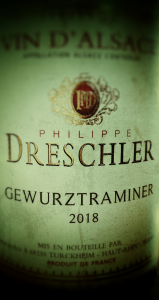
The quick review for that wine read as follows:
You fall asleep naked in a meadow of honeysuckle when, suddenly, a chorus of angels rains the blessings of heaven upon you while playing Debussy; Jean-Luc Godard wishes he was this breathless. The nose is floral, with hints of honey and sweet apple. The honey carries over to the palate in droves, and gives the impression of sugar, but it’s illusion. In fact, this is not oversweet, but certainly sweeter than German offerings of the same grape. Melon and cantaloupe and only the faintest hint of typical Gewurztraminer spice. No tang at all. As I write this, it’s December 27th, and this delicious g’wertz represents the first 5-star rating for all of 2021. I paired with mutton and lentils, and it rose the plate to absolute ecstasy; even non-wine lovers enjoyed a tasting during the dinner. Pure joy all around. Went equally well with a balsamic vinegar salad course, showing off the gymnastics a good Gewurztraminer will go to in order to work with any plate you can throw at it. Don’t let the price point dissuade you into thinking this is anything but a stellar wine.
In a sense, it wasn’t a fair fight. My favorite grape of all is the gwertz, a wine that originally opened my appreciation for white wines, after a decade or more of tilting to the tintos. And the best of that grape comes from Alsace, without exception. And things were even more unfair given the low number of wines reviewed. But I’m happy to award the Dreschler a cinco, and call it the Winepisser Best Wine 2022. Congratulations to the folks at Dreschler.
Coming in at 4.5 stars we found these great runner-ups:
- Bodega Norton Quorum VI Red Blend – Argentina – NV
- La Val Orballo RÃas Baixas Albarino (Fermentado en Barrica) – Spain – 2015
- Chateau Haut-Surget Lalande-de-Pomerol – France – 2019
- Chateau Haut-Caplane Sauternes – France – 2017
- Chateau des Fines Roches Chateauneuf-du-Pape – France – 2015
Of these, the closest were probably the 2017 Sauternes and the 2015 CDP, which deserved slightly higher than a mere 4.5, but still not 5.0.
On the other side of the coin we have the Winepisser Worst Wine 2021 being earned by the absolutely disastrous 2011 Pinord Chateldon Reserva Cabernet Sauvignon from Spain. My God, was that bad. For that review, I wrote:
Gunpowder truck blows up near a pepper mill, enterprising vintner bottles the ashes. I rated this same vintage back in 2019, and hated it. Back then I wrote, “You poured your old uncle a nice glass of cab while he was grilling, but he’s easily confused, and accidentally poured pepper over his glass of wine rather than the steaks.” I felt I might have been unfair, so grabbed a bottle to try again. No improvement, it’s just a bad wine. Earned 2 stars back in 2019, and didn’t improve its score in 2021.
There were, at least, no 1-star wines this year.
Now we rush into 2022 with a new batch of reviews, and 12 more months until the next cinco is awarded!
French Wine Reviews Incoming!
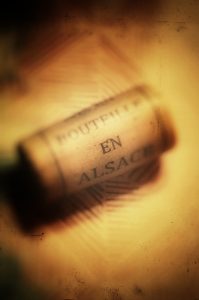 As readers will know, I live in Lima Peru, where it’s flooded with Malbecs from Argentina and all sorts of New World wines from Chile. Having been previously spoiled in the US where I traveled frequently, never far from an upscale wine boutique or, at least, a Total Wine megastore, living in Peru was a shock. Gone were the endless options for wines such as a Tokaji from Hungary or some super-rich Bordeaux.
As readers will know, I live in Lima Peru, where it’s flooded with Malbecs from Argentina and all sorts of New World wines from Chile. Having been previously spoiled in the US where I traveled frequently, never far from an upscale wine boutique or, at least, a Total Wine megastore, living in Peru was a shock. Gone were the endless options for wines such as a Tokaji from Hungary or some super-rich Bordeaux.
Peru is not an advanced wine country by any stretch, as I have written about previously. My neighbors and friends here may be horrified to hear me say it, but Peru is simply ass-backwards in this area of culture. If a wine doesn’t taste like a raisin, they are not up for it.
Now add COVID to the mix, and 2021 was a rough year to be a street-level, gutterpunk wine reviewer. Even though my focus is on affordable wines, for much of the year I had no access to wine at all, given that much of the stuff had been stored in tiendas that were shut down, without air conditioning. The vinegar industry must have loved this season.
Thankfully, as shops and importers began to re-open, I found more and more offering local delivery, allowing me to start up wine reviews again without having to break quarantine or travel restrictions. Panuts offered me a fairly large supply of New World wines (again, mostly from Argentina and Chile, with a smattering from Italy and Spain). And, more recently, I discovered Franco Peru, a Peruvian importer of French wines. (No luck, so far, on any similar operations offering bottles from Germany or California.)
This means we’ll have a brief rush of French wine reviews before the end of the year, and it’s already born fruit (pardon the pun.) An Alsatian Gewurztraminer has already won the first 5-star review of 2021, pushing it ahead of the 4- and 4.5-star reviews from the rest of the year. (It really looked like 2021 might have to award a Winepisser Best Wine award to a wine that had not earned a full five stars.) We should be able to get in a few more reviews before the end of the year, possibly a French Chateauneuf-du-Pape, a Sauternes, and maybe a few authentic Bordeaux — no promises, though, as December 31 is set to arrive quickly.
So 2021 may have been a weak year in total wines reviewed by your Winepisser, but at least we should have a healthy competition among those that made the cut.
No matter who wins, I will be grateful for 2021 as it raised my appreciation for a few grapes I had been otherwise ambivalent about: namely, Albariño and some creative Argentinian red blends.
It certainly looks like a French wine will win this year, but it will be a result of a limited selection, and not wine snobbery. In the meantime, before I resume international travel, I will keep searching for importers who can get me a wider variety of bottles, from a wider geographic region.
Quick Cuttings
